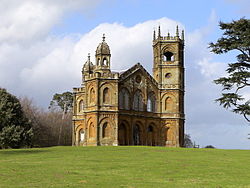Difference between revisions of "Gothic Temple, Stowe"
(Created page with "{{Infobox LT |name=The Gothic Temple |county=Buckinghamshire |picture=Stowe Gothic Temple.jpg |picture caption=The Gothic Temple |os grid ref=SP67913744 |latitude=52.03125441...") |
(No difference)
|
Latest revision as of 06:35, 14 April 2021
| The Gothic Temple | |
|
Landmark Trust | |
|---|---|
 The Gothic Temple | |
| Grid reference: | SP67913744 |
| Location: | 52°1’53"N, 1°-0’41"W |
| Built 1741-1748 | |
| Information | |
The Gothic Temple or the Gothic Tower is a folly tower on the Stowe Park estate. It has in recent years been restored by the Landmark Trust and is available for holiday lets.
The tower was designed by James Gibbs in 1741 and completed about 1748. It is the only building in the gardens of Stowe Park built from ironstone: all the others use a creamy-yellow limestone. The building is triangular in plan of two storeys with a pentagonal shaped tower at each corner, one of which rises two floors higher than the main building, while the other two towers have lanterns on their roofs.
Above the door of the tower is a quote from Pierre Corneille's play Horace: Je rends grace aux Dieux de n'estre pas Roman ('I thank the gods I am not a Roman'). The phrase and the use of the Gothic medium express Richard Grenville's attachment to Whig philosophy, celebrating the nation's Anglo-Saxon heritage in opposition to the classical, Roman culture cultivated by the Tories of the day.
The interior of the Temple includes a circular room of two storeys covered by a shallow dome that is painted to mimic mosaic work including shields representing the Heptarchy (the seven Anglo-Saxon kingdoms of England). It is dedicated 'To the Liberty of our Ancestors'. John Martin Robinson observed:
[1]to the Whigs, Saxon and Gothic were interchangeably associated with freedom and ancient English liberties: trial by jury (erroneously thought to have been founded by King Alfred at a moot on Salisbury Plain), Magna Carta, parliamentary representation, all the things which the Civil War and Glorious Revolution had protected from the wiles of Stuart would-be absolutism, and to the preservation of which Lord Cobham and his 'Patriots' were seriously devoted.
The Temple was used in the 1930s by the school as the Officer Training Corps armoury. It is now available as a holiday let through the Landmark Trust.
Outside links
| ("Wikimedia Commons" has material about Gothic Temple, Stowe) |
References
- ↑ Philips, George and Robinson, John Martin: 'Temples of Delight: Stowe Landscape Gardens' '(1990) page 102